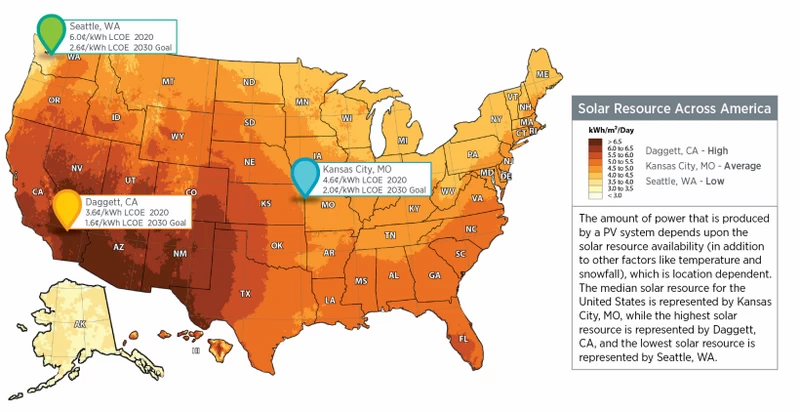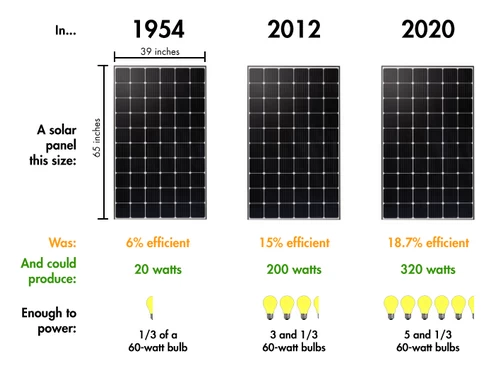Page Contents
- How Much Power Can a Solar Panel Produce?
- Factors affecting power output from a solar panel
- The specific solar panel features that affect power production down the line
- Calculating the annual power output of a full array of solar panels under various climatic conditions
- What are the most common sizes of solar panels for residential use?
- How do you figure out how much energy your solar panels are producing (in kWh)?
- How much energy is produced annually per square foot by a solar panel?
- Does the weight of a solar panel affect its energy output?
- How much power does an average solar panel produce annually per square foot?
- What is the power rating for the average solar panel?
- How much power does different household equipment consume in a year?
- Factors to Consider When Purchasing A Solar Panel
- Conclusion
- Related solar news

How Much Power Can a Solar Panel Produce?
Solar power is clean, renewable energy that can help a homeowner reduce their monthly energy bill. Knowing how much energy your solar panels make in a day can help you decide how many solar panels you’d like to purchase for your home.
Factors affecting power output from a solar panel
Various factors affect the amount of energy produced by an average-sized solar panel. These factors can be grouped into two;
- The amount of solar irradiation the solar panel is exposed to as determined by the installation location
- The structural features and characteristics of the solar panel itself
The specific solar panel features that affect power production down the line
All solar panels have specific wattage volumes they are designed to produce. This wattage volume is the primary determinant of how much power a solar panel produces.
We are interested in knowing the maximum wattage a solar panel can produce in optimum conditions. Optimum test conditions for a solar panel include an average solar cell temperature of twenty-five degrees Celsius and 1000 megajoules of solar radiation per square meter of the solar panel surface.
These optimum conditions are nearly impossible to achieve in reality because of constant weather changes. They do, however, give us a base to calculate and measure solar panel energy output.
Solar panels are constructed by connecting a series of solar cells. In general, residential solar panels available in 2021 will be either 260-330 watts with 60 solar cells joined together, or 360-400 watts with 72 cells joined together. Here is more information on how solar panels work
Obviously, the higher the wattage of the solar panel, the more electricity it will produce when exposed to a fixed amount of solar irradiation.
Calculating the annual power output of a full array of solar panels under various climatic conditions
The average daily electricity production from 1kW of peak DC solar panels installed in each state of the United States is depicted on the map below.

For example, on average…. in California, 1 kW of peak DC solar panel power produces 5,0 kWh per day, or 1,825 kWh per year, according to the map.
We know that if one 275-watt solar panel is 18.85 square feet, then 1 kW (1000 watt) of panels will require 3.63 of these solar panels, and thus will take up 68.42 square feet, based on the example of a standard residential polycrystalline solar panel we used above.
Solar panels installed in California on average produce 26.67 kWh (kilowatt hours) per square foot per year, assuming 1kW of panels produces 1,825 kWh per year and 1kW of panels takes up 68.42 square feet.
To do the same math for your state, use the table of solar power production per kW above.

What are the most common sizes of solar panels for residential use?
Monocrystalline or polycrystalline solar cells will make up the majority of solar panels used in home solar systems in 2020. Although monocrystalline solar panels are slightly more efficient than polycrystalline panels, the size difference is typically less than 5%.
A typical residential solar panel measures 39 inches wide by 65 inches tall.

The smaller squares within the larger panel on each panel can be seen. Each of these is a solar cell, connected in series to produce the panel's electrical characteristics.
How do you figure out how much energy your solar panels are producing (in kWh)?
There are three ways to figure out how much electricity your solar panels will produce, how many you’ll need, and how much roof space they’ll take up at your house. There are three ways to do it: lazy, very lazy, and science nerd.
To figure out how much solar you need, the science nerd method is to look up meteorological data for your location, measure the direction and tilt of your roof, and look at your power usage patterns and net metering scheme available from your utility.
The simple solution is to use one of the many free online solar panel calculators that already have all of this information programmed in them and will automatically calculate all of these things for you as well as estimate the cost of solar panels based on solar company pricing in your area when you enter your zip code, power bill, and utility provider.
The disadvantage is that you must enter your information and they will attempt to provide you with solar quotes, but let’s face it, with net metering and a 26% solar tax credit now available, getting proper solar quotes is probably a good idea anyway.
Because the direction, tilt, and shading of your roof will affect the energy production you will get from solar panels, online estimates are not as accurate as a quote from a solar company that has viewed your roof online. This is the only real way to know you have accurate information on which to make a solar decision.
How much energy is produced annually per square foot by a solar panel?
When calculating the annual electricity generated by solar panels per foot, we must consider more than the panel’s specifications; we must also consider the climate in which the panel is installed.
Given the latitude at which the panel is being installed, we’ll assume the installations are on a perfect south-facing roof with an optimal tilt angle.
Even after removing the variability associated with different roofs, we must still consider the climatic conditions of the location where the solar panel will be installed, as this will influence how much sun the panel receives.
Does the weight of a solar panel affect its energy output?
Each one of the above solar panel types features different weights. Most solar panels weigh 40 pounds, but some can be as light as 33 pounds. A solar panel’s weight is determined by the materials used in the manufacturing process. The weight of a solar panel does not affect its energy output but the material used does.
How much power does an average solar panel produce annually per square foot?
When it comes to solar panels, size is not indicative of power output. Small but efficient solar panels can produce the same energy levels compared to larger ones with poor-quality parts. Calculating solar power output is not an esoteric mathematical concept. You may not have to do the math if the panel has a displayed energy output tag when you buy it.
If you aren’t buying a new solar panel, you can work out the power output by first calculating the panel’s surface area. If the solar panel is 64 inches by 39 inches, the surface area is 1.61 square meters. Assuming your solar panel is the 300-watt type, the peak instantaneous energy production at optimum testing conditions would be 14.58 watts per square foot.
What is the power rating for the average solar panel?
Most solar panels on the market today have a power rating ranging between 250 and 400 watts. The output is affected by the size of the solar panel as it directly corresponds with the exposed surface area. The efficiency of the solar panel to convert solar energy into electricity also affects the average output.
Most homeowners prefer the high output solar panels for their homes. However, solar power output is not the only factor you should consider when purchasing a solar system.
How much power does different household equipment consume in a year?
Here is a list of power consumption that can help you regulate your power consumption and use your solar energy wisely. These statistics are from residential electricity consumption research conducted in 2015.

Most families cannot live without essential household appliances like air conditioners and water heating systems. That said, most families can reduce the lighting bill by switching off lights they are not using. Taking shorter showers can also go a long way in saving energy within the homestead. Next time you open the refrigerator door, keep it brief; keeping the fridge door open for a long time negatively impacts your energy bill.
Sunlight coverage
Most regions of the world get a decent amount of sunlight in a year, so solar panels can be used virtually anywhere the sun shines. Homeowners have to look into energy storage options in areas where the sun doesn’t shine for a few months. They can use the stored power during dark winter months before recharging in the summer. You can calculate how many hours of sun you’ll get so you can develop strategies for harvesting the most solar energy.
Factors to Consider When Purchasing A Solar Panel
The average solar panel in the United States makes about 4.5 kWh per day. This amount may vary depending on the type of solar panel you use. However, power output is not the only factor buyers should consider; a few other factors affect a buyer’s decision-making process.
Research studies in the solar energy industry are geared towards overcoming these minor drawbacks for a steady, reliable, and efficient solar energy supply.
Conclusion
The type of solar panel you purchase affects the installation process and how the panels will look on your roof. Some consumers are interested in aesthetics while others are interested in energy efficiency; whichever feature you are focused on, power output remains a central focal point when purchasing a solar panel.






Hi;
Thank you for contacting me. You have a very good article.
I will be delighted to add it to my website.
Thank you once again,
Walter Sorochan